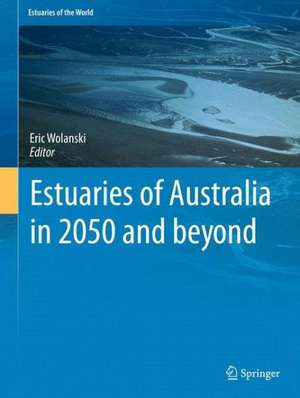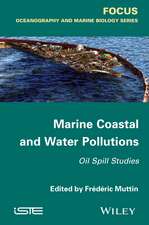Estuaries of Australia in 2050 and beyond: Estuaries of the World
Editat de Eric Wolanskien Limba Engleză Hardback – 12 sep 2013
To answer these questions, this book reports detailed studies of 20 iconic Australian estuaries and bays by leading Australian estuarine scientists.
That knowledge is synthesised in time and space across Australia to suggest what Australian estuaries will look like in 2050 and beyond based on socio-economic decisions that are made now, and changes that are needed to ensure sustainability.
The book also has a Prologue by Mr Malcolm Fraser, former Prime Minister of Australia, which bridges environmental science, population policy and sustainability.
| Toate formatele și edițiile | Preț | Express |
|---|---|---|
| Paperback (1) | 651.51 lei 6-8 săpt. | |
| SPRINGER NETHERLANDS – 28 aug 2015 | 651.51 lei 6-8 săpt. | |
| Hardback (1) | 606.43 lei 38-44 zile | |
| SPRINGER NETHERLANDS – 12 sep 2013 | 606.43 lei 38-44 zile |
Preț: 606.43 lei
Preț vechi: 758.04 lei
-20% Nou
Puncte Express: 910
Preț estimativ în valută:
116.04€ • 121.15$ • 96.04£
116.04€ • 121.15$ • 96.04£
Carte tipărită la comandă
Livrare economică 01-07 aprilie
Preluare comenzi: 021 569.72.76
Specificații
ISBN-13: 9789400770188
ISBN-10: 9400770189
Pagini: 270
Ilustrații: XVII, 292 p.
Dimensiuni: 210 x 279 x 20 mm
Greutate: 1.16 kg
Ediția:2014
Editura: SPRINGER NETHERLANDS
Colecția Springer
Seria Estuaries of the World
Locul publicării:Dordrecht, Netherlands
ISBN-10: 9400770189
Pagini: 270
Ilustrații: XVII, 292 p.
Dimensiuni: 210 x 279 x 20 mm
Greutate: 1.16 kg
Ediția:2014
Editura: SPRINGER NETHERLANDS
Colecția Springer
Seria Estuaries of the World
Locul publicării:Dordrecht, Netherlands
Public țintă
ResearchCuprins
1. Estuaries of Australia in 2050 and beyond - A synthesis.- PART I - Estuaries that bore the full pressure of the historical developments.- 2. Sydney Estuary, Australia: Geology, anthropogenic development and hydrodynamic processes/attributes.- 3. The Murray/Coorong Estuary. Meeting of the Waters?.- 4. Port Phillip Bay.- 5. The Tamar Estuary, Tasmania.- PART II Estuaries being degraded.- 6. Gold Coast Broadwater: Southern Moreton Bay, Southeast Queensland (Australia).- 7. Hydrodynamics and sediment transport in a macro-tidal estuary: Darwin Harbour, Australia.- 8. The Ord River estuary: a regulated wet-dry tropical river system.- 9. South Australia’s Precious Inverse Estuaries: On the road to ruin.- 10. Turbulent Mixing and Sediment Processes in Peri-Urban Estuariesin South-East Queensland (Australia).- 11. Hervey Bay and Its Estuaries.- 12. Moreton Bay and its estuaries: A sub-tropical system under pressure from rapid population growth.- 13. Water resource development and high value coastal wetlands on the lower Burdekin floodplain, Australia.-14. The Hawkesbury Estuary from 1950 to 2050.- PART III - Estuaries that are still relatively pristine.- 15. Deluge Inlet, a pristine small tropical estuary in north-eastern Australia.- 16. The Lower Mary River and flood plains.
Recenzii
From the reviews:
“This nicely illustrated book is a wonderful mix of case studies, geographical descriptions, history, scientifically-based predictions, socio-economic anecdotes, and fundamental physical, biological, chemical and environmental science … . It is written at a level where most readers, specialist scientists or not, will have no difficulty following the text and appreciating the arguments. As a summary of the historical, the current, and the anticipated status of Australian estuaries, on a level that can be appreciated by almost everybody, it is excellent.” (Reg Uncles, ECSA Bulletin, Issue 62, 2014)
“This nicely illustrated book is a wonderful mix of case studies, geographical descriptions, history, scientifically-based predictions, socio-economic anecdotes, and fundamental physical, biological, chemical and environmental science … . It is written at a level where most readers, specialist scientists or not, will have no difficulty following the text and appreciating the arguments. As a summary of the historical, the current, and the anticipated status of Australian estuaries, on a level that can be appreciated by almost everybody, it is excellent.” (Reg Uncles, ECSA Bulletin, Issue 62, 2014)
Notă biografică
Dr. Eric Wolanski is a coastal oceanographer and ecohydrologist. Eric has 360 publications; he is a fellow of the Australian Academy of Technological Sciences and Engineering, the Institution of Engineers Australia (ret.), and l'Académie Royale des Sciences d'Outre-Mer. He was awarded an Australian Centenary medal for services in estuarine and coastal oceanography, a Doctorate Honoris Causa from the catholic University of Louvain, a Queensland Information Technology and Telecommunication award for excellence, and the Estuarine and Coastal Sciences Association (ECSA) Lifetime Achievement Award. Eric is a member of the IGBP-IHDP Scientific Steering Committee of Land-Ocean Interactions in the Coastal Zone (LOICZ), and a member of the Scientific Planning Committee of Japan’s Environmental Management of Enclosed Coastal Seas (EMECS). He is a chief editor of Estuarine, Coastal and Shelf Science, Wetlands Ecology and Management, and the Treatise of Estuarine and Coastal Science.
Textul de pe ultima copertă
The book addresses the questions: Is Australia’s rapidly growing human population and economy environmentally sustainable for its estuaries and coasts? What is needed to enable sustainable development?
To answer these questions, this book reports detailed studies of 20 iconic Australian estuaries and bays by leading Australian estuarine scientists.
That knowledge is synthesised in time and space across Australia to suggest what Australian estuaries will look like in 2050 and beyond based on socio-economic decisions that are made now, and changes that are needed to ensure sustainability.
The book also has a Prologue by Mr Malcolm Fraser, former Prime Minister of Australia, which bridges environmental science, population policy and sustainability.
To answer these questions, this book reports detailed studies of 20 iconic Australian estuaries and bays by leading Australian estuarine scientists.
That knowledge is synthesised in time and space across Australia to suggest what Australian estuaries will look like in 2050 and beyond based on socio-economic decisions that are made now, and changes that are needed to ensure sustainability.
The book also has a Prologue by Mr Malcolm Fraser, former Prime Minister of Australia, which bridges environmental science, population policy and sustainability.
Caracteristici
A synthesis of the environmental status of iconic Australian estuaries and bays by eminent Australian scientists Suggests what Australian estuaries will look like in 2050 and beyond based on socio-economic decisions that are made now, and changes that are needed to ensure sustainability Intended for researchers, practitioners, (under) graduates in all disciplines dealing with complex problems as well as methodological tools to set up truly transversal science and technology projects, such as the restoration of damaged habitats Includes supplementary material: sn.pub/extras


















